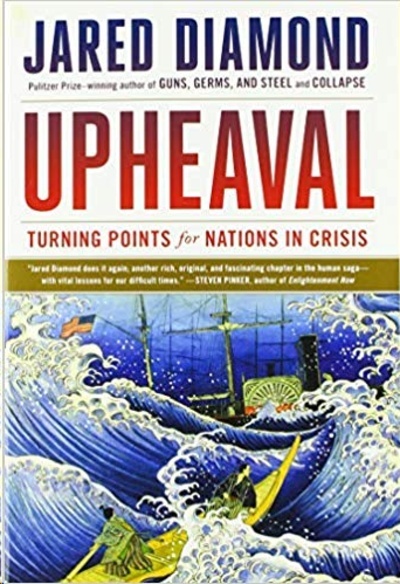Upheaval : Turning Points for Nations in Crisis

Editorial Little&Brown
Fecha de edición mayo 2019 · Edición nº 1
Idioma inglés
EAN 9780316492645
512 páginas
Libro
encuadernado en tapa blanda
Resumen del libro
A "riveting and illuminating" (Yuval Noah Harari) new theory of how and why some nations recover from trauma and others don't, by the Pulitzer-Prize-winning author of the landmark bestsellers Guns, Germs, and Steel and Collapse.
In his international bestsellers Guns, Germs and Steel and Collapse, Jared Diamond transformed our understanding of what makes civilizations rise and fall. Now, in his third book in this monumental trilogy, he reveals how successful nations recover from crises while adopting selective changes -- a coping mechanism more commonly associated with individuals recovering from personal crises.
Diamond compares how six countries have survived recent upheavals -- ranging from the forced opening of Japan by U.S. Commodore Perry's fleet, to the Soviet Union's attack on Finland, to a murderous coup or countercoup in Chile and Indonesia, to the transformations of Germany and Austria after World War Two.
Because Diamond has lived and spoken the language in five of these six countries, he can present gut-wrenching histories experienced firsthand. These nations coped, to varying degrees, through mechanisms such as acknowledgment of responsibility, painfully honest self-appraisal, and learning from models of other nations. Looking to the future, Diamond examines whether the United States, Japan, and the whole world are successfully coping with the grave crises they currently face.
Can we learn from lessons of the past?
Adding a psychological dimension to the in-depth history, geography, biology, and anthropology that mark all of Diamond's books, Upheaval reveals factors influencing how both whole nations and individual people can respond to big challenges. The result is a book epic in scope, but also his most personal book yet.
Biografía del autor
x{0026}lt;P x{0026}lt;B Jared Diamondx{0026}lt;/B (1937) es catedrático de geografía en la Universidad de California (UCLA). Comenzó su actividad científica en el campo de la fisiología evolutiva y la biogeografía. Ha sido elegido miembro de la Academia de Artes y Ciencias, de la Academia Nacional de Ciencias y de la Sociedad Filosófica de Estados Unidos, y ha recibido una beca de investigación de la Fundación MacArthur, además de los premios Burr de la Sociedad Geográfica Nacional y Pulitzer de 1998 por x{0026}lt;I Armas, gérmenes y acerox{0026}lt;/I (1997).x{0026}lt;/P x{0026}lt;P Ha publicado más de seiscientos artículos en las revistas x{0026}lt;I Discoverx{0026}lt;/I , x{0026}lt;I Natural Historyx{0026}lt;/I , x{0026}lt;I Nature y Geox{0026}lt;/I . También es autor de x{0026}lt;I El tercer chimpancéx{0026}lt;/I (1994), x{0026}lt;I ¿Por qué es divertido el sexo?x{0026}lt;/I (1999), x{0026}lt;I Colapso x{0026}lt;/I (2006), x{0026}lt;I El mundo hasta ayerx{0026}lt;/I (2013) y x{0026}lt;I Sociedades comparadasx{0026}lt;/I (Debate, 2016) grandes éxitos que han obtenido, además, numerosos galardones.x{0026}lt;/P








